Java开发中的23种设计模式详解(2)结构型
我们接着讨论设计模式,上篇文章我讲完了5种创建型模式,这章开始,我将讲下7种结构型模式:适配器模式、装饰模式、代理模式、外观模式、桥接模式、组合模式、享元模式。其中对象的适配器模式是各种模式的起源,我们看下面的图:
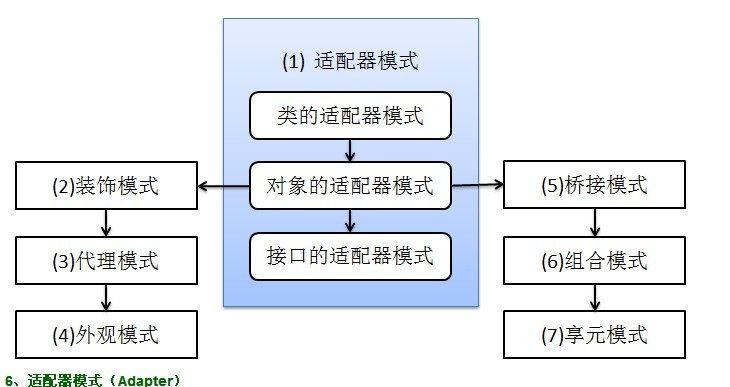
适配器模式将某个类的接口转换成客户端期望的另一个接口表示,目的是消除由于接口不匹配所造成的类的兼容性问题。主要分为三类:类的适配器模式、对象的适配器模式、接口的适配器模式。首先,我们来看看类的适配器模式,先看类图:
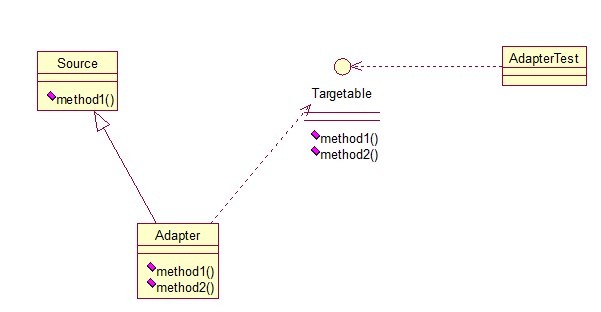
核心思想就是:有一个Source类,拥有一个方法,待适配,目标接口时Targetable,通过Adapter类,将Source的功能扩展到Targetable里,看代码:
- public class Source {
- public void method1() {
- System.out.println("this is original method!");
- }
- }
- public interface Targetable {
- /* 与原类中的方法相同 */
- public void method1();
- /* 新类的方法 */
- public void method2();
- }
- public class Adapter extends Source implements Targetable {
- @Override
- public void method2() {
- System.out.println("this is the targetable method!");
- }
- }
Adapter类继承Source类,实现Targetable接口,下面是测试类:
- public class AdapterTest {
- public static void main(String[] args) {
- Targetable target = new Adapter();
- target.method1();
- target.method2();
- }
- }
输出:
this is original method!
this is the targetable method!
这样Targetable接口的实现类就具有了Source类的功能。
对象的适配器模式
基本思路和类的适配器模式相同,只是将Adapter类作修改,这次不继承Source类,而是持有Source类的实例,以达到解决兼容性的问题。看图:
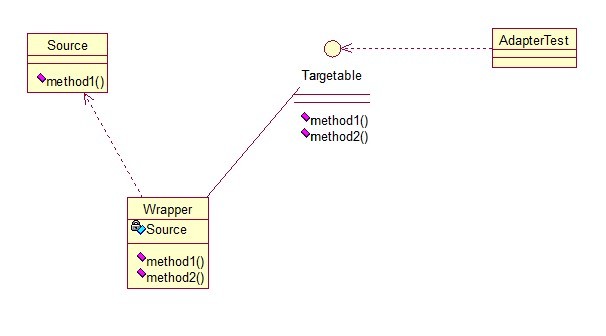
只需要修改Adapter类的源码即可:
- public class Wrapper implements Targetable {
- private Source source;
- public Wrapper(Source source){
- super();
- this.source = source;
- }
- @Override
- public void method2() {
- System.out.println("this is the targetable method!");
- }
- @Override
- public void method1() {
- source.method1();
- }
- }
测试类:
- public class AdapterTest {
- public static void main(String[] args) {
- Source source = new Source();
- Targetable target = new Wrapper(source);
- target.method1();
- target.method2();
- }
- }
输出与第一种一样,只是适配的方法不同而已。
第三种适配器模式是接口的适配器模式,接口的适配器是这样的:有时我们写的一个接口中有多个抽象方法,当我们写该接口的实现类时,必须实现该接口的所有方法,这明显有时比较浪费,因为并不是所有的方法都是我们需要的,有时只需要某一些,此处为了解决这个问题,我们引入了接口的适配器模式,借助于一个抽象类,该抽象类实现了该接口,实现了所有的方法,而我们不和原始的接口打交道,只和该抽象类取得联系,所以我们写一个类,继承该抽象类,重写我们需要的方法就行。看一下类图:
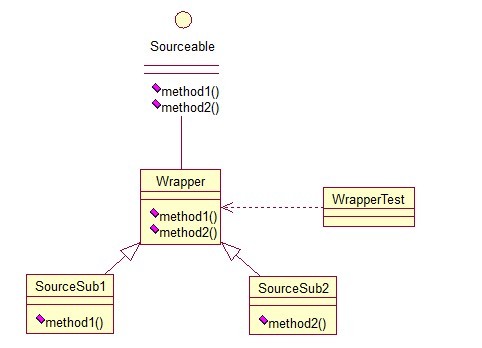
这个很好理解,在实际开发中,我们也常会遇到这种接口中定义了太多的方法,以致于有时我们在一些实现类中并不是都需要。看代码:
- public interface Sourceable {
- public void method1();
- public void method2();
- }
抽象类Wrapper2:
- public abstract class Wrapper2 implements Sourceable{
- public void method1(){}
- public void method2(){}
- }
- public class SourceSub1 extends Wrapper2 {
- public void method1(){
- System.out.println("the sourceable interface's first Sub1!");
- }
- }
- public class SourceSub2 extends Wrapper2 {
- public void method2(){
- System.out.println("the sourceable interface's second Sub2!");
- }
- }
- public class WrapperTest {
- public static void main(String[] args) {
- Sourceable source1 = new SourceSub1();
- Sourceable source2 = new SourceSub2();
- source1.method1();
- source1.method2();
- source2.method1();
- source2.method2();
- }
- }
测试输出:
the sourceable interface's first Sub1!
the sourceable interface's second Sub2!
达到了我们的效果!
讲了这么多,总结一下三种适配器模式的应用场景:
类的适配器模式:当希望将一个类转换成满足另一个新接口的类时,可以使用类的适配器模式,创建一个新类,继承原有的类,实现新的接口即可。
对象的适配器模式:当希望将一个对象转换成满足另一个新接口的对象时,可以创建一个Wrapper类,持有原类的一个实例,在Wrapper类的方法中,调用实例的方法就行。
接口的适配器模式:当不希望实现一个接口中所有的方法时,可以创建一个抽象类Wrapper,实现所有方法,我们写别的类的时候,继承抽象类即可。
7、装饰模式(Decorator)
顾名思义,装饰模式就是给一个对象增加一些新的功能,而且是动态的,要求装饰对象和被装饰对象实现同一个接口,装饰对象持有被装饰对象的实例,关系图如下:
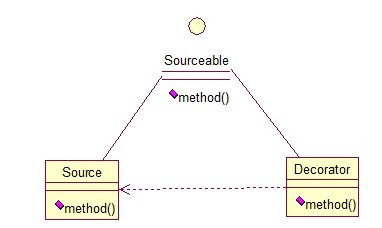
Source类是被装饰类,Decorator类是一个装饰类,可以为Source类动态的添加一些功能,代码如下:
- public interface Sourceable {
- public void method();
- }
- public class Source implements Sourceable {
- @Override
- public void method() {
- System.out.println("the original method!");
- }
- }
- public class Decorator implements Sourceable {
- private Sourceable source;
- public Decorator(Sourceable source){
- super();
- this.source = source;
- }
- @Override
- public void method() {
- System.out.println("before decorator!");
- source.method();
- System.out.println("after decorator!");
- }
- }
测试类:
- public class DecoratorTest {
- public static void main(String[] args) {
- Sourceable source = new Source();
- Sourceable obj = new Decorator(source);
- obj.method();
- }
- }
输出:
before decorator!
the original method!
after decorator!
装饰器模式的应用场景:
1、需要扩展一个类的功能。
2、动态的为一个对象增加功能,而且还能动态撤销。(继承不能做到这一点,继承的功能是静态的,不能动态增删。)
缺点:产生过多相似的对象,不易排错!
8、代理模式(Proxy)
其实每个模式名称就表明了该模式的作用,代理模式就是多一个代理类出来,替原对象进行一些操作,比如我们在租房子的时候回去找中介,为什么呢?因为你对该地区房屋的信息掌握的不够全面,希望找一个更熟悉的人去帮你做,此处的代理就是这个意思。再如我们有的时候打官司,我们需要请律师,因为律师在法律方面有专长,可以替我们进行操作,表达我们的想法。先来看看关系图: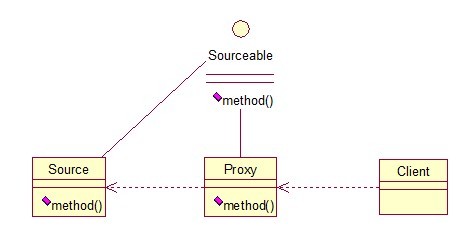
根据上文的阐述,代理模式就比较容易的理解了,我们看下代码:
- public interface Sourceable {
- public void method();
- }
- public class Source implements Sourceable {
- @Override
- public void method() {
- System.out.println("the original method!");
- }
- }
- public class Proxy implements Sourceable {
- private Source source;
- public Proxy(){
- super();
- this.source = new Source();
- }
- @Override
- public void method() {
- before();
- source.method();
- atfer();
- }
- private void atfer() {
- System.out.println("after proxy!");
- }
- private void before() {
- System.out.println("before proxy!");
- }
- }
测试类:
- public class ProxyTest {
- public static void main(String[] args) {
- Sourceable source = new Proxy();
- source.method();
- }
- }
输出:
before proxy!
the original method!
after proxy!
代理模式的应用场景:
如果已有的方法在使用的时候需要对原有的方法进行改进,此时有两种办法:
1、修改原有的方法来适应。这样违反了“对扩展开放,对修改关闭”的原则。
2、就是采用一个代理类调用原有的方法,且对产生的结果进行控制。这种方法就是代理模式。
使用代理模式,可以将功能划分的更加清晰,有助于后期维护!
9、外观模式(Facade)
外观模式是为了解决类与类之家的依赖关系的,像spring一样,可以将类和类之间的关系配置到配置文件中,而外观模式就是将他们的关系放在一个Facade类中,降低了类类之间的耦合度,该模式中没有涉及到接口,看下类图:(我们以一个计算机的启动过程为例)
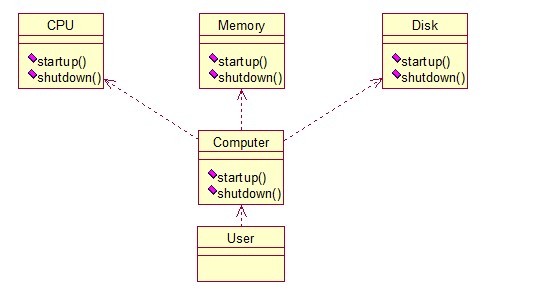
我们先看下实现类:
- public class CPU {
- public void startup(){
- System.out.println("cpu startup!");
- }
- public void shutdown(){
- System.out.println("cpu shutdown!");
- }
- }
- public class Memory {
- public void startup(){
- System.out.println("memory startup!");
- }
- public void shutdown(){
- System.out.println("memory shutdown!");
- }
- }
- public class Disk {
- public void startup(){
- System.out.println("disk startup!");
- }
- public void shutdown(){
- System.out.println("disk shutdown!");
- }
- }
- public class Computer {
- private CPU cpu;
- private Memory memory;
- private Disk disk;
- public Computer(){
- cpu = new CPU();
- memory = new Memory();
- disk = new Disk();
- }
- public void startup(){
- System.out.println("start the computer!");
- cpu.startup();
- memory.startup();
- disk.startup();
- System.out.println("start computer finished!");
- }
- public void shutdown(){
- System.out.println("begin to close the computer!");
- cpu.shutdown();
- memory.shutdown();
- disk.shutdown();
- System.out.println("computer closed!");
- }
- }
User类如下:
- public class User {
- public static void main(String[] args) {
- Computer computer = new Computer();
- computer.startup();
- computer.shutdown();
- }
- }
输出:
start the computer!
cpu startup!
memory startup!
disk startup!
start computer finished!
begin to close the computer!
cpu shutdown!
memory shutdown!
disk shutdown!
computer closed!
如果我们没有Computer类,那么,CPU、Memory、Disk他们之间将会相互持有实例,产生关系,这样会造成严重的依赖,修改一个类,可能会带来其他类的修改,这不是我们想要看到的,有了Computer类,他们之间的关系被放在了Computer类里,这样就起到了解耦的作用,这,就是外观模式!
10、桥接模式(Bridge)
桥接模式就是把事物和其具体实现分开,使他们可以各自独立的变化。桥接的用意是:将抽象化与实现化解耦,使得二者可以独立变化,像我们常用的JDBC桥DriverManager一样,JDBC进行连接数据库的时候,在各个数据库之间进行切换,基本不需要动太多的代码,甚至丝毫不用动,原因就是JDBC提供统一接口,每个数据库提供各自的实现,用一个叫做数据库驱动的程序来桥接就行了。我们来看看关系图:
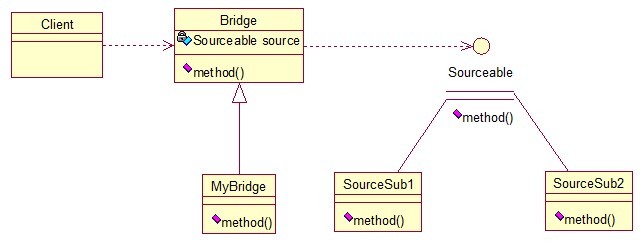
实现代码:
先定义接口:
- public interface Sourceable {
- public void method();
- }
分别定义两个实现类:
- public class SourceSub1 implements Sourceable {
- @Override
- public void method() {
- System.out.println("this is the first sub!");
- }
- }
- public class SourceSub2 implements Sourceable {
- @Override
- public void method() {
- System.out.println("this is the second sub!");
- }
- }
定义一个桥,持有Sourceable的一个实例:
- public abstract class Bridge {
- private Sourceable source;
- public void method(){
- source.method();
- }
- public Sourceable getSource() {
- return source;
- }
- public void setSource(Sourceable source) {
- this.source = source;
- }
- }
- public class MyBridge extends Bridge {
- public void method(){
- getSource().method();
- }
- }
测试类:
- public class BridgeTest {
- public static void main(String[] args) {
- Bridge bridge = new MyBridge();
- /*调用第一个对象*/
- Sourceable source1 = new SourceSub1();
- bridge.setSource(source1);
- bridge.method();
- /*调用第二个对象*/
- Sourceable source2 = new SourceSub2();
- bridge.setSource(source2);
- bridge.method();
- }
- }
output:
this is the first sub!
this is the second sub!
这样,就通过对Bridge类的调用,实现了对接口Sourceable的实现类SourceSub1和SourceSub2的调用。接下来我再画个图,大家就应该明白了,因为这个图是我们JDBC连接的原理,有数据库学习基础的,一结合就都懂了。

11、组合模式(Composite)
组合模式有时又叫部分-整体模式在处理类似树形结构的问题时比较方便,看看关系图:
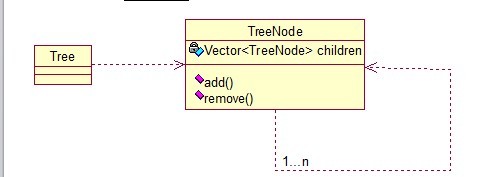
直接来看代码:
- public class TreeNode {
- private String name;
- private TreeNode parent;
- private Vector<TreeNode> children = new Vector<TreeNode>();
- public TreeNode(String name){
- this.name = name;
- }
- public String getName() {
- return name;
- }
- public void setName(String name) {
- this.name = name;
- }
- public TreeNode getParent() {
- return parent;
- }
- public void setParent(TreeNode parent) {
- this.parent = parent;
- }
- //添加孩子节点
- public void add(TreeNode node){
- children.add(node);
- }
- //删除孩子节点
- public void remove(TreeNode node){
- children.remove(node);
- }
- //取得孩子节点
- public Enumeration<TreeNode> getChildren(){
- return children.elements();
- }
- }
- public class Tree {
- TreeNode root = null;
- public Tree(String name) {
- root = new TreeNode(name);
- }
- public static void main(String[] args) {
- Tree tree = new Tree("A");
- TreeNode nodeB = new TreeNode("B");
- TreeNode nodeC = new TreeNode("C");
- nodeB.add(nodeC);
- tree.root.add(nodeB);
- System.out.println("build the tree finished!");
- }
- }
使用场景:将多个对象组合在一起进行操作,常用于表示树形结构中,例如二叉树,数等。
12、享元模式(Flyweight)
享元模式的主要目的是实现对象的共享,即共享池,当系统中对象多的时候可以减少内存的开销,通常与工厂模式一起使用。
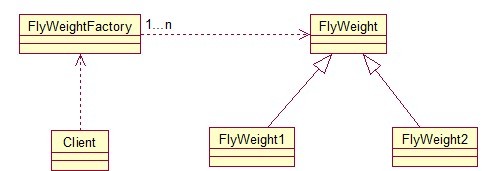
FlyWeightFactory负责创建和管理享元单元,当一个客户端请求时,工厂需要检查当前对象池中是否有符合条件的对象,如果有,就返回已经存在的对象,如果没有,则创建一个新对象,FlyWeight是超类。一提到共享池,我们很容易联想到Java里面的JDBC连接池,想想每个连接的特点,我们不难总结出:适用于作共享的一些个对象,他们有一些共有的属性,就拿数据库连接池来说,url、driverClassName、username、password及dbname,这些属性对于每个连接来说都是一样的,所以就适合用享元模式来处理,建一个工厂类,将上述类似属性作为内部数据,其它的作为外部数据,在方法调用时,当做参数传进来,这样就节省了空间,减少了实例的数量。
看个例子:
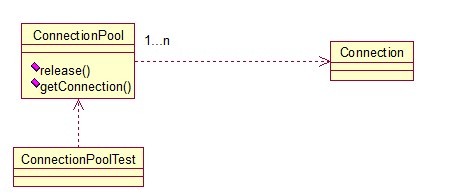
看下数据库连接池的代码:
- public class ConnectionPool {
- private Vector<Connection> pool;
- /*公有属性*/
- private String url = "jdbc:mysql://localhost:3306/test";
- private String username = "root";
- private String password = "root";
- private String driverClassName = "com.mysql.jdbc.Driver";
- private int poolSize = 100;
- private static ConnectionPool instance = null;
- Connection conn = null;
- /*构造方法,做一些初始化工作*/
- private ConnectionPool() {
- pool = new Vector<Connection>(poolSize);
- for (int i = 0; i < poolSize; i++) {
- try {
- Class.forName(driverClassName);
- conn = DriverManager.getConnection(url, username, password);
- pool.add(conn);
- } catch (ClassNotFoundException e) {
- e.printStackTrace();
- } catch (SQLException e) {
- e.printStackTrace();
- }
- }
- }
- /* 返回连接到连接池 */
- public synchronized void release() {
- pool.add(conn);
- }
- /* 返回连接池中的一个数据库连接 */
- public synchronized Connection getConnection() {
- if (pool.size() > 0) {
- Connection conn = pool.get(0);
- pool.remove(conn);
- return conn;
- } else {
- return null;
- }
- }
- }
Java开发中的23种设计模式详解(2)结构型的更多相关文章
- [ 转载 ] Java开发中的23种设计模式详解(转)
Java开发中的23种设计模式详解(转) 设计模式(Design Patterns) ——可复用面向对象软件的基础 设计模式(Design pattern)是一套被反复使用.多数人知晓的.经过分类 ...
- Java开发中的23种设计模式详解
[放弃了原文访问者模式的Demo,自己写了一个新使用场景的Demo,加上了自己的理解] [源码地址:https://github.com/leon66666/DesignPattern] 一.设计模式 ...
- Java开发中的23种设计模式详解(转)
设计模式(Design Patterns) ——可复用面向对象软件的基础 设计模式(Design pattern)是一套被反复使用.多数人知晓的.经过分类编目的.代码设计经验的总结.使用设计模式是为了 ...
- 0. Java开发中的23种设计模式详解(转)
设计模式(Design Patterns) ——可复用面向对象软件的基础 设计模式(Design pattern)是一套被反复使用.多数人知晓的.经过分类编目的.代码设计经验的总结.使用设计模式是为了 ...
- (转)Java开发中的23种设计模式详解
原文出自:http://blog.csdn.net/zhangerqing 一.设计模式的分类 总体来说设计模式分为三大类: 创建型模式,共五种:工厂方法模式.抽象工厂模式.单例模式.建造者模式.原型 ...
- 【java】java开发中的23种设计模式详解
设计模式(Design Patterns) ——可复用面向对象软件的基础 设计模式(Design pattern)是一套被反复使用.多数人知晓的.经过分类编目的.代码设计经验的总结.使用设计模式是为了 ...
- 面试题:Java开发中的23种设计模式详解(转)
设计模式(Design Patterns) ——可复用面向对象软件的基础 设计模式(Design pattern)是一套被反复使用.多数人知晓的.经过分类编目的.代码设计经验的总结.使用设计模式是为了 ...
- Java开发中的23种设计模式详解 【转】
创建型模式,共五种:工厂方法模式.抽象工厂模式.单例模式.建造者模式.原型模式. 行为型模式,共十一种:策略模式.模板方法模式.观察者模式.迭代子模式.责任链模式.命令模式.备忘录模式.状态模式.访问 ...
- 2016/1/18 Java开发中的23种设计模式详解(转)
设计模式(Design Patterns) ——可复用面向对象软件的基础 设计模式(Design pattern)是一套被反复使用.多数人知晓的.经过分类编目的.代码设计经验的总结.使用设计模式是为了 ...
- Java开发中的23种设计模式详解(收藏-转)
设计模式(Design Patterns) ——可复用面向对象软件的基础 设计模式(Design pattern)是一套被反复使用.多数人知晓的.经过分类编目的.代码设计经验的总结.使用设计模式是为了 ...
随机推荐
- myeclipse2014删除antlr-2.7.2.jar--解决struts和hibernate包冲突
方式一: 要求眼疾手快,在workspace下的D:\myeclipse2014workspace\.metadata\.me_tcat7\webapps\工程名\WEB-INF\lib中将antlr ...
- java的任务
1.完善现有的日志记录系统,对异常进行处理和记录 2.基于需求实现账号信息录入接口
- 四、Angular新建组件和使用
1.新建组件命令 ng component 组件路径 如果报错换成 ng generate component 组件路径 2.组件 ts 文件详解 3.组件会自动引入到app.mudule.ts里面 ...
- 接口需要上一个接口的返回值(unittest)
import unittest,requests ''' 使用unittest框架的时候,这个接口需要上一个接口的返回值 ''' class Test_case(unittest.TestCase): ...
- Java数据类型转换题目
题目一 public static void main(String[] args) { byte b1 = 1, b2 = 2, b3, b6, b8; final byte b4 = 4, b5 ...
- Java web入门之Http请求和响应
三层架构 web层:JSP + Servlet.Struts 2.SpringMVC service层:Spring dao层:JDBC.DBUtils.Hibernate.MyBatis form表 ...
- shell中的双引号和单引号
参考链接:http://bbs.chinaunix.net/thread-2076396-1-1.html " "(双引号)与 ' '(单引号)的区别 你在shell prompt ...
- Web核心之最简单最简单最简单的登录页面
需求分析: 在登录页面提交用户名和密码 在Servlet中接收提交的参数,封装为User对象,然后调用DAO中的方法进行登录验证 在DAO中进行数据库查询操作,根据参数判断是否有对象的用户存在 在Se ...
- 查完数据库order_by后跟[:9]切片取前9位的值
- PHP curl_multi_add_handle函数
curl_multi_add_handle — 向curl批处理会话中添加单独的curl句柄 说明 int curl_multi_add_handle ( resource $mh , resourc ...
